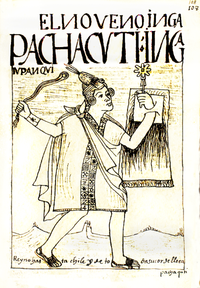Pachacuti
![]()
This article or subsequent section is not sufficiently supported by evidence (e.g., anecdotal evidence). Information without sufficient evidence may be removed in the near future. Please help Wikipedia by researching the information and adding good supporting evidence.
Pachacútec Yupanqui, according to Peruvian Quechua spelling Pachakutiq Yupanki, originally Cusi Yupanqui or Kusi Yupanki († 1471) was the ninth ruler over the Inca Empire from 1438 to 1471.
The reign of Kusi Yupanki began with his victory as army commander over the Chankas. The Chankas, themselves an expanding empire, posed a serious threat to the Incas and in 1438, under their leader Anku Walluq, laid siege to the capital of Qusqu (Cusco) with a reported 40,000 men. Kusi Yupanki's aged father, Huiracocha Inca (Wiraqucha Inca), withdrew to the fortress of Calca with his son Urco (Urqu), who was intended as heir to the throne, and other loyal followers. Kusi Yupanki then took charge of the Inca army, routed Qusqu with the help of his allies, the K'anas (Cana) and Qanchis (Canchi), and destroyed the Chanka force at the Battle of Yawarpampa ("Blood Plain" at the hill of Carmenca/Cuzco); the territory of the Chankas was incorporated into the Inca Empire. This event represents a turning point (Pachakuti) in the Inca tradition. The victorious army commander became king of the Incas and since then bore the name "world changer", Pachakutiq Yupanki.
According to one of several theories, the city of Machu Picchu was founded around 1450 at the instigation of Pachacútec Yupanqui.
In 1460, his brother Cápac Yupanqui (Qhapaq Yupanki) succeeded in subduing the Wanka in Junín after fierce fighting. After an unsuccessful campaign in Huánuco, in which numerous Chanka mercenaries deserted from the Inca army, Pachakutiq had his brother executed in Cusco.
Under Pachakutiq, the Inca Empire was expanded from Lake Titicaca in the central Andes to Junín. Above all, he had the infrastructure in his empire significantly expanded and caused the economy to be boosted by new technologies. Since his reign there are exact historical records, that means for example the birth and death dates of Incas were written down since then. Little is known about the circumstances of his personal life. His successor was his son Túpac Yupanqui.

Pachacútec Yupanqui
Questions and Answers
Q: Who was Pachacuti Inca Yupanqui?
A: Pachacuti Inca Yupanqui was the ninth Sapa Inca (1438-1471/1472) of the Kingdom of Cuzco, who transformed it into the Tawantinsuyu empire.
Q: What does Pachacuti's name mean?
A: Pachacuti's name means "He who remakes the world" in Quechua.
Q: Who was Pachacuti's wife, and who was their son?
A: Pachacuti's wife was named Mama Anawarkhi or Coya Anahurque, and their son was Tupac Inca Yupanqui.
Q: What did Pachacuti do to reorganize the new empire?
A: Pachacuti reorganized the empire into the Tahuantinsuyu or "the united four provinces." Under his system, there were four apos that each controlled one of four provinces (suyu).
Q: Did Pachacuti improve upon the system of choosing the next Inca?
A: No, Pachacuti did not improve upon the system of choosing the next Inca, as his son became the next Inca without any known dispute. In future generations, the next Inca had to gain control of the empire by winning enough support from the apos, priesthood, and military to either win a civil war or intimidate anyone else from trying to get control of the empire.
Q: How far did the Inca dominion expand under Pachacuti's conquests?
A: Within three generations, the Inca dominion expanded from the valley of Cuzco to nearly the whole of civilized South America under Pachacuti's conquests.
Q: When is Machu Picchu believed to date back to?
A: Machu Picchu is believed to date back to the time of Pachacuti.
Search within the encyclopedia